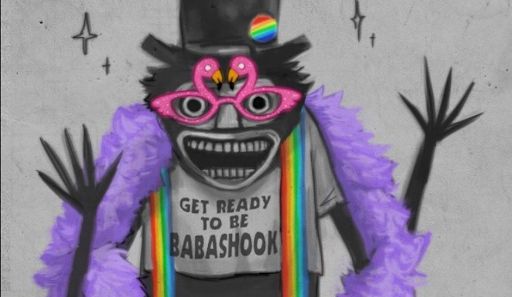
Seasonal allergy season is almost over and TikTok is full of mid-level influencers critiquing the latest rainbow romper offerings at their local Target, which can only mean one thing: Pride Month has officially arrived!
Every year since 1999, June has been a time to celebrate the kaleidoscope of identities within the 2SLGBTQIA+ community, but also to reflect on the narratives that shape our understanding of these diverse experiences. It’s also a chance to see the Babadook in daisy dukes dropping it like it’s hot at an outdoor festival to a dubstep remix of a Whitney Houston song. But horror icons clapping cheeks aside, Pride Month is so much more than a parade or weekend celebration; it’s a vibrant tapestry woven with the threads of resilience, courage, and love. It’s a time to honor the trailblazers who paved the way and to reaffirm our commitment to the ongoing fight for equality. It’s a month to remember how we got here and to reassess the tools we need to continue to evolve. Among those tools, few are as important as the written word.
Early this year, I had the privilege of lending my voice to a panel at the Association of Writers and Writing Programs (AWP) Conference. We discussed the current state of queer books and identified a gap. Among the difficult coming out stories and tragic tales, where are the queer characters navigating the mundane complexities of everyday life? Not just gay or bisexual people. Where are the other equally important members of our community centered in tales that are unrelated to the journey of their sexual preference or gender identity?
What I’ve learned partnering with bookstores as an event host is that many traditional publishing houses have been slow to embrace the call for evolved LGBTQIA+ portrayals, clinging to outdated notions of what constitutes marketable fiction. Thankfully, publishers like 4 Horsemen Publications are brave enough to challenge the status quo and step up to fill this void. They recognize the demand for stories which accurately mirror the full spectrum of human experience.
Readers of all ages crave tales that delve into the nuances of asexual, polyamorous, pansexual, agender, transgender, non-binary identities, and everything in between. They want romance, mystery, people like them living their life after the coming out stage (or characters who never had to go through one at all). While coming out can be an important part of the queer reality, stories with a shifted focus also resonate with authenticity, offering validation and representation to those who are often overlooked.
4 Horsemen Publications’ commitment to championing these kinds of diverse voices is not just commendable; it’s essential. By taking a chance on chronicles that challenge industry expectations, they’re paving the way for a more inclusive literary landscape. They’re showing that there’s both a hunger and marketability for stories which showcase the colorful mosaic of human identity.
As we enjoy the festivities of Pride Month, it’s important to remember why we celebrate. Pride is about reclaiming our narratives. Affirming our existence. Telling society who we are and that we plan on staying. In a world that often seeks to erase or silence us, working with publishers who are on our side is among the ways we continue to progress.
Books have the ability to change hearts and minds, to foster empathy and understanding, and to illuminate the shared humanity that binds us all together. When we write and champion diverse stories, we’re not just enriching our literary landscape; we’re fostering a more compassionate and inclusive society.
So this Pride Month, grab your local Babadook or drag performer by the hand and throw some glitter on. Raise your voice in celebration of all the stories yet to be told. Imagine what we could learn from each other if we printed more books than we banned, let more people tell their stories than we tossed in the “slush” pile, stopped telling queer authors their experiences aren’t book-worthy because they can’t be packaged and sold like trauma-flavored bubblegum.
Let’s embrace the power of literature to inspire change and uplift marginalized voices, continue to push for a world where every identity is not just acknowledged, but shared. With the help of publishers like 4HP, we can create space for characters representing every letter of the 2SLGBTQIA+ community. As authors and readers, we have the power to mold the narratives of tomorrow.
Happy Pride Everyone. Keep reading. Keep fighting.


